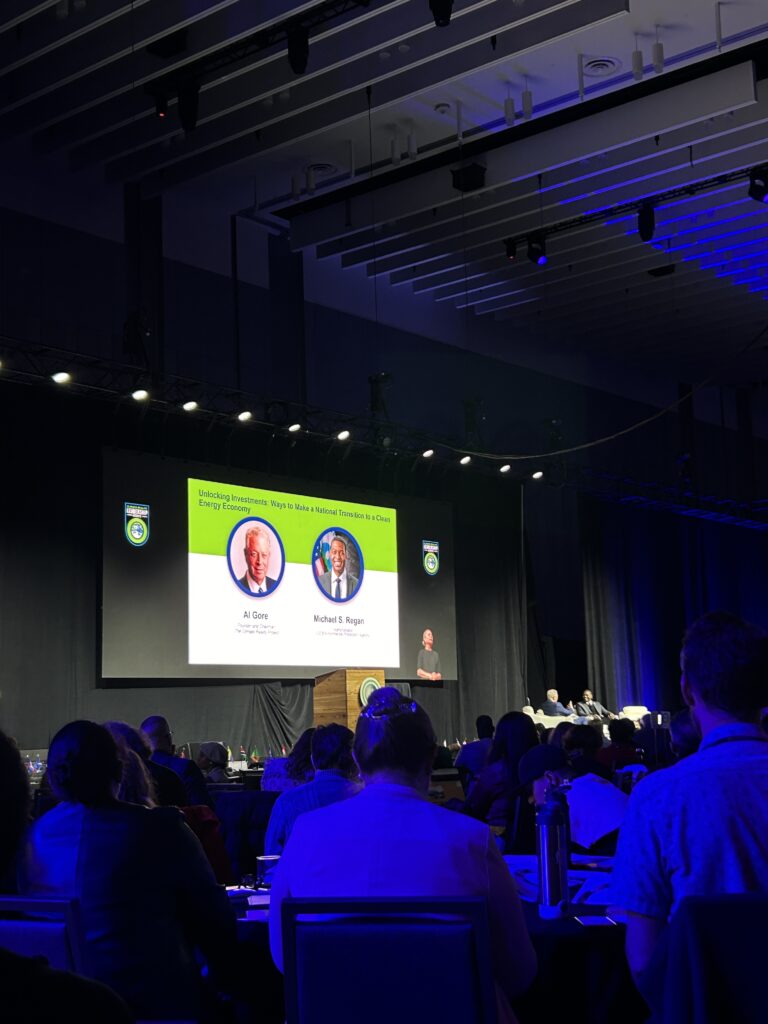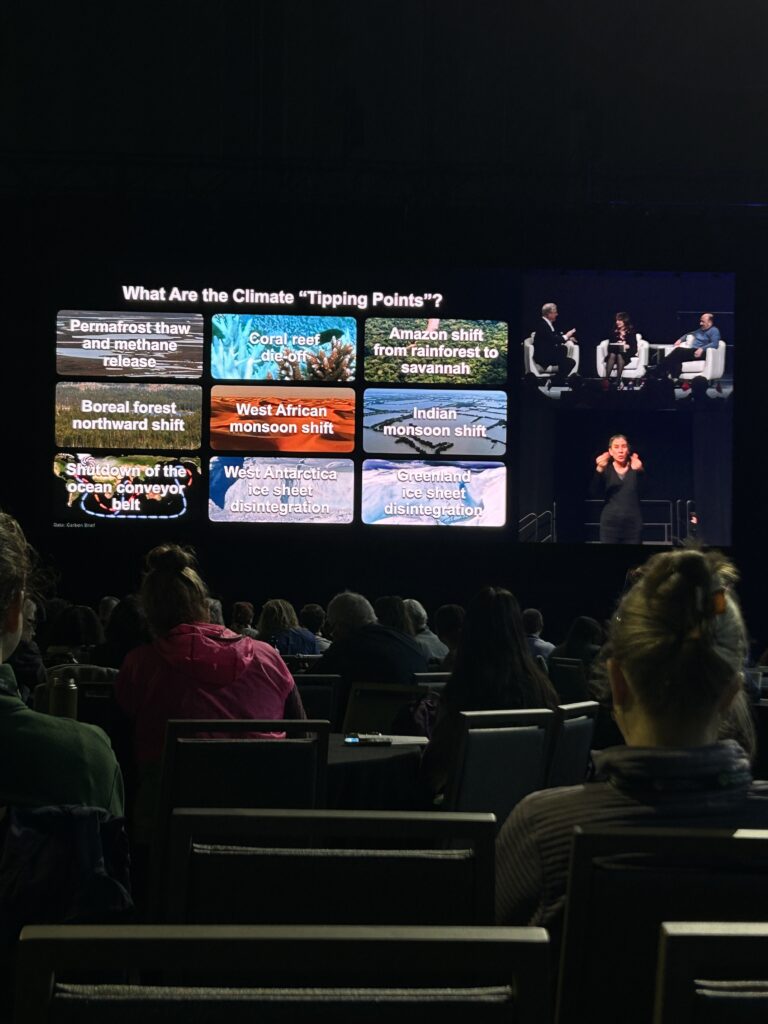Climate Reality Leadership Training 4/12- 4/14
by Clariss Mancebo
Over the weekend of April 12th to 14th I had the honor and privilege of attending Climate Reality’s annual training conference. At the conference, I was given the opportunity to witness several panels and speeches where brilliant people expressed their passion and love for the environment and the intricacies of climate action. The panels were filled with people of all ages and backgrounds providing truly expansive conversations. It was particularly incredible to witness former Vice President Al Gore interview activists and discuss the climate through the panels and his iconic slide show.
Day 1:
Day one introduced many incredible speakers with different perspectives regarding the climate crisis. The initial speaker, Sophia Powless, shared the story of her home in the Onondaga nation and the troubles they faced due to the pollution of what historically was a food source for the people who lived there. She discussed growing up having to cover her nose when driving past the lake because the smell was so horrid. While there was sadness in her discussion of the Onondaga Lake there was still hope in her voice that there could be a solution that restored the lake to a place that could be brought back to her community. Powless finished her opening remarks by introducing the idea of the Seventh Generation Principle which presents to us the idea that any action we take should consider how it will impact the Earth for the next seven generations. As Powless said, children seven generations from now deserve to experience the hemlock trees just as she did as a child.
Later, Powless opened the floor to VP Al Gore where he proceeded to interview several people making strides in climate activism. Of these many people was Amar Bhattacharya who discussed the importance of investments in the transition to a global economy that focuses on clean energy. In their conversation, Al Gore questioned why it was so difficult to invest in underdeveloped countries such as Africa where there are ample resources but few projects. Mr. Bhattacharya answered this question by explaining that for more investment to occur in these areas, the investments need to be “de-risked.” Essentially, these investments need to be backed by infrastructure that can guarantee that there will not be a major loss of money for investors. But they continued this conversation by explaining that the few projects that were invested in were successes and well surpassed expectations; as Amar Bhattacharya said, “Money and resources are not the problems, political will is.”
Another interesting conversation from the first batch of panels was between VP Al Gore and Michael Regan, Administrator of the United States Environmental Protection Agency. The bulk of the conversation centered around the Inflation Reduction Act which was an incredible stride by the government in committing to a clean energy economy. Mr. Regan discussed particularly the commitment by President Biden in the IRA to allot 40% of the investment to historically marginalized communities. This continued into a discussion of environmental racism and the increased impact of climate change on Black and Brown low-income communities because of the historically racist infrastructure that has put these communities at the front lines of the climate crisis. Michael Regan stated that the IRA was a step against both environmental and systemic racism.

Day 2:
On the second day, Vice President Al Gore presented his incredibly detailed PowerPoint explaining scientific research that has been done regarding the climate crisis and the current predictions based on solutions. The first section of his presentation focused on the current state of the environment and what led us here. He discussed industrialization and the refusal by certain public figures to acknowledge that there is a serious need to address the way the world works because we only have one planet. After this section, Al Gore began to discuss the probable solutions and the false solutions proposed by the fossil fuel industry. Specifically, he discussed the proposal by these industries of carbon capture. He clarified with a graph the strides made in clean energy sources as opposed to the ineffective attempts by fossil fuel companies to increase the capture of carbon from factories that burn fossil fuels. Mr. Gore finished his slides with a section explaining that a net zero carbon future was not only possible but could be achieved by mid-century. Mr. Gore’s presentation was extremely optimistic and expressed a genuine belief in a near future where the global climate temperatures stop rising and we reach net zero carbon emissions but was still critical of the current state of energy usage.

Day 3:
The final day of the conference had a panel presented by three community leaders from across the United States. This panel was the most interesting panel to me personally because it was presented by people with completely different backgrounds yet all on the front lines of the climate crisis. The conversation was held between Eddie Bautista the Executive Director of New York City Environmental Justice Alliance, Roberto Múkaro, the Kasike, or Chief, of the Guainía Taíno Tribe of Borikén and the Strategic Advisor of the Center for Earth Ethics, and Heaven Sensky the Organizing Director of Center for Coalfield Justice. This conversation was labeled as a discussion of intersectionality in climate justice and for good reason. These three leaders discussed the impacts on their specific communities, not just the climate crisis but the attempts at “solutions” for the climate crisis. Eddie Bautista spoke specifically about environmental racism and the imposition of negative effects on Black and Brown working-class communities. He additionally discussed how in areas like Brooklyn gentrification plays a large part in keeping these marginalized groups from experiencing the benefits of green infrastructure. Mr. Bautista explained that there had been a movement from Williamsburg to rezone and take part in Sunset Park which would be a large source of wind energy. This rezoning would have taken natural resources and green jobs from Sunset Park, which has a majority Latino population. Roberto Múkaro discussed how Indigenous communities have always had the best interest of the environment at heart but were frequently romanticized and disregarded as not truly having knowledge that could benefit the environment and serve as a solution. One of Mr. Múkaro’s large points was that 80% of the United States’ biodiversity is held in Indigenous land and this is because they not only have the best interest of the land at heart due to cultural practices, but they also know how to protect the land. Mr. Múkaro wanted to highlight that the solution of providing nature with rights was something to be wary of because it has historically been used as a land-grab tactic against Indigenous communities. Heaven Sensky’s discussion was incredibly interesting because from my experience it is a frequently overlooked perspective. Heaven Sensky comes from an Appalachian coal mining town and highlighted that solutions from the rest of the United States do not seem like solutions for people in mining towns. Ms. Sensky explains that areas like the one where she lives are considered “sacrifice zones” because they are fossil fuel extraction frontlines. Their entire conversation highlights the absolute necessity that conversations regarding solutions from the climate be intersectional because a solution for one group is not a solution for every group and a sweet spot needs to be found.
Clariss Mancebo, John Jay Class of 2024, is a Humanities and Justice Major, and a Law as well as an Environmental Justice Minor. She is the Vice President of the Environmental Club and the John Jay Campus Leader for Rewild Your Campus.